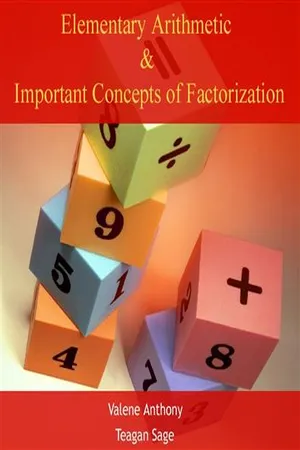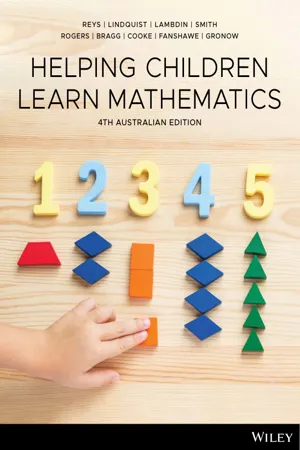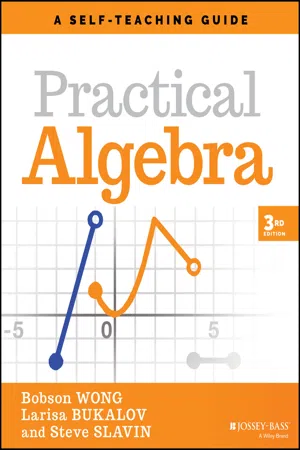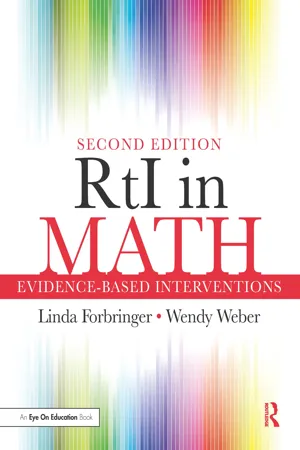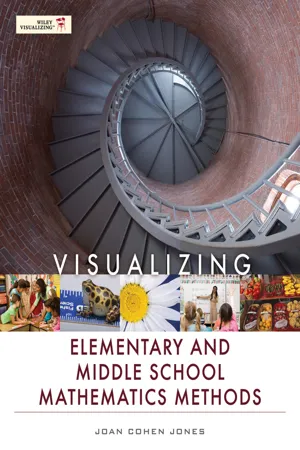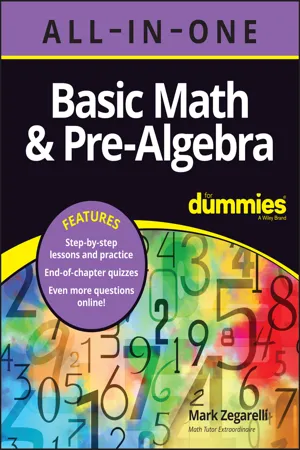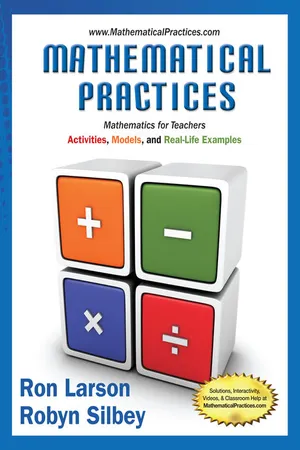Mathematics
Addition, Subtraction, Multiplication and Division
Addition, subtraction, multiplication, and division are the four basic arithmetic operations used to manipulate numbers. Addition combines two or more numbers to find their total, while subtraction finds the difference between two numbers. Multiplication is the process of repeated addition, and division is the process of splitting a number into equal parts. These operations are fundamental to solving mathematical problems.
Written by Perlego with AI-assistance
Related key terms
1 of 5
10 Key excerpts on "Addition, Subtraction, Multiplication and Division"
- No longer available |Learn more
- Tom Bassarear, Meg Moss(Authors)
- 2015(Publication Date)
- Cengage Learning EMEA(Publisher)
3 The Four Fundamental Operations of Arithmetic SECTION 3.1 Understanding Addition SECTION 3.2 Understanding Subtraction SECTION 3.3 Understanding Multiplication SECTION 3.4 Understanding Division Learning how to add, subtract, multiply, and divide and then applying this knowledge to solve problems makes up the lion’s share of elementary school mathematics. The Common Core State Standards introduce addition and subtraction of whole numbers with concrete models, pictures, and strategies for numbers less than 100 in first grade. By fifth grade, students are performing all four operations with whole numbers and decimals. Operations with fractions begin in fourth grade, and with negative numbers in sixth grade. Our focus here will be understanding that • The operations have multiple meanings vs. one single meaning—for example, subtrac-tion is more than simply “take away.” • These meanings are often connected—for example, one meaning of multiplication is repeated addition. • There are many algorithms (standard procedures) for each operation; the one you learned for each operation is simply one of many. • Knowledge of base ten and place value is vitally important to see how these algo-rithms work. • Practice and memorization are important, but practice without understanding is a waste of time. SECTION Understanding Addition 3.1 What do you think? ● How many words, aside from combine , can you think of that describe addition? ● Not having place value, how might the Romans have added, for example, XXXVIII 1 XXVI? HISTORY We cannot overemphasize the fact that most of our everyday mathemat-ics is actually quite recent. During the Middle Ages, many mathemati-cians considered an operation to be any mathematical technique or procedure that was considered im-portant. It has only been in the last century that mathematicians have linked the concept of operation to the concept of function. 1 75 Copyright 2016 Cengage Learning. All Rights Reserved. - No longer available |Learn more
- (Author)
- 2014(Publication Date)
- Learning Press(Publisher)
________________________ WORLD TECHNOLOGIES ________________________ Chapter- 3 Addition and Subtraction Addition 3 + 2 = 5 with apples, a popular choice in textbooks Addition is a mathematical operation that represents combining collections of objects together into a larger collection. It is signified by the plus sign (+). For example, in the picture on the right, there are 3 + 2 apples—meaning three apples and two other apples— which is the same as five apples. Therefore, 3 + 2 = 5. Besides counts of fruit, addition can also represent combining other physical and abstract quantities using different kinds of numbers: negative numbers, fractions, irrational numbers, vectors, decimals and more. Addition follows several important patterns. It is commutative, meaning that order does not matter, and it is associative, meaning that when one adds more than two numbers, order in which addition is performed does not matter. Repeated addition of 1 is the same as counting; addition of 0 does not change a number. Addition also obeys predictable rules concerning related operations such as subtraction and multiplication. All of these rules can be proven, starting with the addition of natural numbers and generalizing up ________________________ WORLD TECHNOLOGIES ________________________ through the real numbers and beyond. General binary operations that continue these patterns are studied in abstract algebra. Performing addition is one of the simplest numerical tasks. Addition of very small numbers is accessible to toddlers; the most basic task, 1 + 1, can be performed by infants as young as five months and even some animals. In primary education, children learn to add numbers in the decimal system, starting with single digits and progressively tackling more difficult problems. Mechanical aids range from the ancient abacus to the modern computer, where research on the most efficient implementations of addition continues to this day. - No longer available |Learn more
- (Author)
- 2014(Publication Date)
- Library Press(Publisher)
________________________ WORLD TECHNOLOGIES ________________________ Chapter 3 Addition and Subtraction Addition 3 + 2 = 5 with apples, a popular choice in textbooks Addition is a mathematical operation that represents combining collections of objects together into a larger collection. It is signified by the plus sign (+). For example, in the picture on the right, there are 3 + 2 apples—meaning three apples and two other apples— which is the same as five apples. Therefore, 3 + 2 = 5. Besides counts of fruit, addition can also represent combining other physical and abstract quantities using different kinds of numbers: negative numbers, fractions, irrational numbers, vectors, decimals and more. Addition follows several important patterns. It is commutative, meaning that order does not matter, and it is associative, meaning that when one adds more than two numbers, order in which addition is performed does not matter. Repeated addition of 1 is the same as counting; addition of 0 does not change a number. Addition also obeys predictable rules concerning related operations such as subtraction and multiplication. All of these rules can be proven, starting with the addition of natural numbers and generalizing up ________________________ WORLD TECHNOLOGIES ________________________ through the real numbers and beyond. General binary operations that continue these patterns are studied in abstract algebra. Performing addition is one of the simplest numerical tasks. Addition of very small numbers is accessible to toddlers; the most basic task, 1 + 1, can be performed by infants as young as five months and even some animals. In primary education, children learn to add numbers in the decimal system, starting with single digits and progressively tackling more difficult problems. Mechanical aids range from the ancient abacus to the modern computer, where research on the most efficient implementations of addition continues to this day. - eBook - PDF
- Robert Reys, Mary Lindquist, Diana V. Lambdin, Nancy L. Smith, Anna Rogers, Audrey Cooke, Bronwyn Ewing, Kylie Robson(Authors)
- 2021(Publication Date)
- Wiley(Publisher)
A fraction result occurs. Emergent understanding of the commutative law for addition and multiplication can be seen when children attempt to apply it to subtraction and division. The idea of ‘subtract the smaller number from the larger’ or ‘divide the larger number by the smaller’ regardless of their order in the operation can be problematic. Care needs to be taken to ensure that children understand why the order is important for subtraction and division. Similarly, caution is needed with the associative law when three or more numbers are involved. Please note that the order of operations is introduced from Year 6 in Australia. If brackets do not appear in a sequence of operations, then the correct order is to work from left to right. An example for subtraction is: 12 – 5 – 4 = (12 – 5) – 4 = 3, but 12 – 5 – 4 ≠ 12 – (5 – 4) or 12 – 1 = 11. An example for division is: 12 ÷ 4 ÷ 2 = (12 ÷ 4) ÷ 2 = 3 ÷ 2 = 1.5, but it is not equal to 12 ÷ (4 ÷ 2) or 12 ÷ 2 = 6. Finally, the distributive law which works for multiplication over addition (or subtraction) doesn’t work for division as shown by the following example: 24 ÷ 6 = 4, but 24 ÷ (4 + 2) ≠ (24 ÷ 4) + (24 ÷ 2); as, 6 + 2 = 18. Care is needed not to apply the commutative, associative and distributive properties to all four operations. 9.4 Overview of learning the basic number facts LEARNING OUTCOME 9.4 Understanding the three-phase process for helping children learn basic number facts. As children develop an understanding of the four operations, learning begins to focus on certain number combinations. These are generally referred to as the basic number facts. The tables of facts in figures 9.6 and 9.7 illustrate all the combinations in abstract form. However, these tables should not simply be rote learnt and replace the development of a conceptual understanding. - eBook - PDF
Practical Algebra
A Self-Teaching Guide
- Bobson Wong, Larisa Bukalov, Steve Slavin(Authors)
- 2022(Publication Date)
- Jossey-Bass(Publisher)
1 BASIC CONCEPTS In this chapter, we review some of the concepts that students are typically expected to know before learning algebra. Although we don’t have the space to fully develop these concepts, we point out some common mistakes and other important points that you should keep in mind. Even if you think that you know these topics, we recommend that you work through this chapter. 1.1 Addition, Subtraction, Multiplication, Division Throughout this book, we use visual models to represent mathematical ideas. One important model is a number line , a line on which each point represents exactly one number. The numbers always increase from left to right. To show the scale, numbers are marked off at equal intervals. We draw an arrow at the end to indicate that the numbers extend infinitely in that direction. Positive numbers , which we indicate with a + in front of the number, are num-bers greater than 0. Negative numbers , which we indicate with a − in front of the number, are numbers less than 0. The word sign refers to the property of being positive or negative. The term signed numbers refers to numbers and their signs. Numbers that don’t have a sign in front of them are understood to be positive. On a horizontal number line (Figure 1.1), positive numbers lie to the right of 0, and negative numbers lie to the left of 0: Did You Know? The idea of positive numbers, negative numbers, and 0 may seem obvious to us now, but they actually developed around the world over thousands of years. By the 3rd century BCE, the Chinese were using counting rods of different colors to represent positive and negative numbers in their calculations. The 7th-century Indian mathematician Brahmagupta described rules in terms of “fortunes” (positive numbers) and “debts” (negative numbers). Ancient societies understood the concept of nothing (“we have no water”), but many cultures, such as the Egyptians, Romans, and Greeks, created complex mathematics without 0. - eBook - ePub
RtI in Math
Evidence-Based Interventions
- Linda Forbringer, Wendy Weber(Authors)
- 2021(Publication Date)
- Routledge(Publisher)
9Operations with Whole Numbers: Multiplication and Division
Number sense and operations with whole numbers form the foundation for all higher mathematics. The IES Practice Guide recommends that “instructional materials for students receiving interventions should focus intensely on in-depth treatment of whole numbers in kindergarten through grade 5” (Gersten et al., 2009 , p. 6). In Chapter 7, we focused on developing number sense, and in Chapter 8, we addressed addition and subtraction of whole numbers. In this chapter, we focus on multiplication and division of whole numbers, The Common Core State Standards lay the foundation for multiplication in second grade, and it is a major focus of third grade mathematics. By the end of third grade, students should understand the concept of multiplication and division and have strategies for multiplying and dividing within 100. By the end of fourth grade, they should be fluent with multiplication and division facts and multi-digit multiplication, and begin developing an understanding of division using multi-digit dividends. Fluency with all whole number operations is expected by the end of sixth grade (National Governors Association, 2010).Developing Conceptual Understanding of Multiplication
Multiplication is an extension of addition, and so students should master the concept of addition before multiplication is introduced. One of the simplest ways to show the relationship between addition and multiplication is with bar models or tape diagrams. In Chapter 8, we described how tape diagrams show the part/whole relationships in addition. The same diagrams also illustrate part/whole relationships in multiplication. See Figure 9.1Figure 9.1Tape Diagrams for Addition and MultiplicationWhen the parts are of different sizes, as they are in the first drawing in Figure 9.1 , we add to find the sum. When all the addends are of equal value, as they are in the second example, we can still solve the problem by adding, but we can also solve the problem by multiplying the number of parts times the value of each part. Either approach provides the correct answer, but multiplication is more efficient. When we introduce multiplication, we want to make sure that students recognize the relationship between multiplication and addition. Multiplication is not some new and strange process. It is simply a more efficient way to solve problems when there are multiple parts that are all the same size. When tape diagrams are used to model multiplication facts, the first factor determines the number of parts. The second factor is written inside each box to show the size of each part, as shown in Figure 9.1 . The multiplication fact 3 × 2 is not written by placing a 3 in one box and a 2 in the other box, because that would model an addition fact. Students frequently make this error when they first learn to use tape diagrams to model multiplication. The number bonds described in Chapter 7 - Joan Cohen Jones(Author)
- 2011(Publication Date)
- Wiley(Publisher)
What are the stages through which children progress as they learn the operations of addition and subtraction? 3. What are the properties of addition? Why is it important for children to learn them? 4. Why is it important for children to learn the inverse relationship between addition and subtraction? Activity 9.4 Plate cover-up Instructions 1. For pairs of children, give each pair two paper plates and a set of counters. 2. Children will turn their paper plates face down. 3. One child places a given number of counters under one plate (6, 7, or 8 counters) and no counters under the second plate. 4. The other child uncovers both paper plates. 5. Ask: How many counters are under the first plate? (6) How many counters are under the second plate? (0) How many counters are there in all? 6. Ask: Can you write addition and subtraction sentences to show this? (6 + 0 = 6; 6 – 0 = 6) 7. The children reverse roles. Continue the activity with other quantities of counters. $1 $1 $1 Garth $1 $1 $1 $1 $1 $1 $1 $1 $1 $1 $1 $1 $1 $1 $1 $1 $1 $1 $1 $1 $1 $1 $1 $1 $1 $1 $1 $1 $1 $1 $1 $1 $1 $1 $1 $1 Aisha $1 $1 $1 $1 $1 $1 $1 $1 $1 $1 $1 $1 $1 $1 $1 $1 $1 $1 $1 $1 $1 $1 $1 $1 $1 $1 $1 $1 $1 $1 $1 $1 $1 226 CHAPTER 9 Operations with Whole Numbers b. COMPARISON Comparison problems involve comparing one quantity in relation to another quantity and reasoning about them multiplicatively. c. COMBINATIONS Combination problems are somewhat harder than the other types because they are more difficult to model. They involve finding out how many different combinations can be made from a given set of objects. There are four types of multiplication and division problems. It is important for you to identify them so that you can supplement the problems found in your children’s textbook. Textbooks often include only the easiest of the problem types (equal groups/product unknown or equal groups/factor unknown). a. EQUAL GROUPS Equal groups problems have three numbers.- eBook - PDF
Mathematics for Elementary Teachers
A Contemporary Approach
- Gary L. Musser, Blake E. Peterson, William F. Burger(Authors)
- 2013(Publication Date)
- Wiley(Publisher)
Thus each child would get nine fruit slices with one left undistributed. This way of looking at division of whole numbers, with a remainder, is summarized next. Reflection from Research Second- and third-grade students tend to use repeated addition to solve simple multiplication AND division problems. In a division problem, such as 15 5 ÷ , they will repeatedly add the divisor until they reach the quotient ( ; ) 5 5 10 10 5 15 + = + = , often using their fingers to keep track of the number of times they use 5 (Mulligan & Mitchelmore, 1995). 110 Chapter 3 Whole Numbers: Operations and Properties Find the quotient and remainder for these problems. a. 57 9 ÷ b. 44 13 ÷ c. 96 8 ÷ SOLUTION a. 9 6 54 × = , so 57 9 6 3 = + ¥ . The quotient is 6 and the remainder is 3 (Figure 3.33). Figure 3.33 b. 13 3 39 × = , so 44 13 3 5 = + ¥ . The quotient is 3 and the remainder is 5. c. 8 12 96 × = , so 96 8 12 0 = + ¥ . The quotient is 12 and the remainder is 0. ■ Problem-Solving Strategy Draw a Picture Repeated-Subtraction Approach Figure 3.34 suggests alternative ways of viewing division. Figure 3.34 In Figure 3.34, 13 was subtracted from 44 three successive times until a number less than 13 was reached, namely 5. Thus 44 divided by 13 has a quotient of 3 and a remainder of 5. This example shows that division can be viewed as repeated subtrac- tion. In general, to find a b ÷ using the repeated-subtraction approach, subtract b successively from a and from the resulting differences until a remainder r is reached, where r b < . The number of times b is subtracted is the quotient q. Figure 3.35 provides a visual way to remember the main interconnections among the four basic whole-number operations. For example, multiplication of whole num- bers is defined by using the repeated-addition approach, subtraction is defined using the missing-addend approach, and so on. - Mark Zegarelli(Author)
- 2022(Publication Date)
- For Dummies(Publisher)
Unit 2The Big Four Operations: Addition, Subtraction, Multiplication, and Division
In This Unit …- Chapter 3: Counting on Success: Numbers and Digits
- Knowing Your Place Value
- Close Enough for Rock ‘n’ Roll: Rounding and Estimating
- Practice Questions Answers and Explanations
- Whaddya Know? Chapter 3 Quiz
- Answers to Chapter 3 Quiz
- Chapter 4: Staying Positive with Negative Numbers
- Understanding Where Negative Numbers Come From
- Sign-Switching: Understanding Negation and Absolute Value
- Addition and Subtraction with Negative Numbers
- Knowing Signs of the Times (and Division) for Negative Numbers
- Practice Questions Answers and Explanations
- Whaddya Know? Chapter 4 Quiz
- Answers to Chapter 4 Quiz
- Chapter 5: Putting the Big Four Operations to Work
- Switching Things Up with Inverse Operations and the Commutative Property
- Getting with the In-Group: Parentheses and the Associative Property
- Understanding Inequalities
- Moving Beyond the Big Four: Exponents and Square Roots
- Practice Questions Answers and Explanations
- Whaddya Know? Chapter 5 Quiz
- Answers to Chapter 5 Quiz
Passage contains an image Chapter 3
Counting on Success: Numbers and Digits
IN THIS CHAPTERUnderstanding how place value turns digits into numbersDistinguishing whether zeros are important placeholders or meaningless leading zerosReading and writing long numbersUnderstanding how to round numbers and estimate valuesWhen you’re counting, ten seems to be a natural stopping point — a nice, round number. The fact that our ten fingers match up so nicely with numbers may seem like a happy accident. But of course, it’s no accident at all. Fingers were the first calculator that humans possessed. Our number system — the Hindu-Arabic numbers, also called the decimal numbers — is based on the number ten because humans have 10 fingers instead of 8 or 12. In fact, the very word digit has two meanings: numerical symbol and finger.In this chapter, I show you how place value turns digits into numbers. I also show you when 0 is an important placeholder in a number and why leading zeros don’t change the value of a number. And I show you how to read and write long numbers. After that, I discuss two important skills: rounding numbers and estimating values.- eBook - PDF
Mathematical Practices, Mathematics for Teachers
Activities, Models, and Real-Life Examples
- Ron Larson, Robyn Silbey(Authors)
- 2014(Publication Date)
- Cengage Learning EMEA(Publisher)
Section 3.3 Multiplying Whole Numbers 97 3.3 Multiplying Whole Numbers Understand and use the definition of the product of two whole numbers. Understand and use the properties of multiplication for whole numbers. Use models to multiply whole numbers. Use algorithms to multiply whole numbers. Understand and use the Distributive Properties. Defining the Product of Two Whole Numbers There is more than one way to define the product of two whole numbers. The most common definition that is given to younger children is to define multiplication as repeated addition. Product of Two Whole Numbers Let n and a be two whole numbers such that n ≠ 0. The product of n and a, written as n ⋅ a, is the whole number such that n ⋅ a = a + a + a + . . . + a. Repeated addition n addends The numbers, n and a, being multiplied are the factors of the product. EXAMPLE 1 Finding the Product of Two Whole Numbers Use the definition of the product of two whole numbers to find each product. a. 8 ⋅ 11 b. The product of 9 and 5 c. Seven times four d. Ten multiplied by nine SOLUTION a. Using the repeated addition definition of multiplication, the product is 8 ⋅ 11 = 11 + 11 + 11 + 11 + 11 + 11 + 11 + 11 = 88. 8 addends b. Using the repeated addition definition of multiplication, the product of 9 and 5 is 9 ⋅ 5 = 5 + 5 + 5 + 5 + 5 + 5 + 5 + 5 + 5 = 45. 9 addends c. “Seven times four” can mean either 7 ⋅ 4 or 4 ⋅ 7. On the next page, you will learn that multiplication is commutative. So, you obtain the same result with either meaning. You usually interpret “7 times 4” to mean 7 groups of 4. 7 ⋅ 4 = 4 + 4 + 4 + 4 + 4 + 4 + 4 = 28 d. “Ten multiplied by nine” is generally interpreted as 10 ⋅ 9. 10 ⋅ 9 = 9 + 9 + 9 + 9 + 9 + 9 + 9 + 9 + 9 + 9 = 90 Example 1 illustrates an important concept in the teaching and learning of mathematics. Mathematical expressions, such as the product of two whole numbers, can be written using symbols. But, expressions can also be written using different word phrases.
Index pages curate the most relevant extracts from our library of academic textbooks. They’ve been created using an in-house natural language model (NLM), each adding context and meaning to key research topics.


